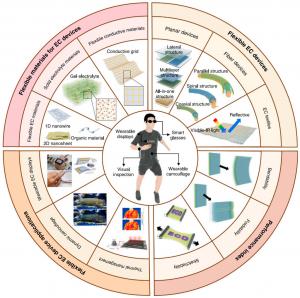Flexible Electrochromic Technology for Next-Generation Wearables
GA, UNITED STATES, July 18, 2025 /EINPresswire.com/ -- This article reviews recent advances in flexible electrochromic (EC) devices for wearable electronics, offering in-depth insights into material innovations, device structures, performance metrics, and practical applications. It also highlights the key challenges and future prospects of flexible EC technologies, aiming to bridge the gap between materials research and real-world implementation in smart wearable systems.
Since the concept of electrochromism (EC) was first proposed in 1961 by J. R. Platt at the University of Chicago, the performance of EC materials and devices has greatly improved over the past few decades.
In recent years, the rapid advancement of the smart wearable sector has spurred the emergence of a new generation of products that are highly flexible, portable, intelligent, and multifunctional—further accelerating the development of EC technologies toward flexibility, rapid color switching, and multicolor capabilities.
In a review article published in KeAi's Wearable Electronics, a team of researchers from China summarized the latest research on flexible electrochromic technology for wearable electronics.
“Wearable systems demand not only flexibility but also energy efficiency and responsiveness,” explains co-corresponding Prof. Kerui Li. “Electrochromic devices meet these requirements while offering dynamic visual feedback.”
In the review, the team highlights new low-dimensional EC materials like WO3 nanowires and V2O5 nanosheets, combined with flexible conductors such as silver nanowires and carbon networks.
“These materials improve both mechanical flexibility and optical performance,” adds Li. “At the same time, solid and gel polymer electrolytes are being developed to enhance flexibility and stability, though challenges remain in conductivity and interface integration.”
“Device structure matters,” says senior author Prof. Hongzhi Wang. “From multi-layered stacks, we've moved to thinner planar and reflective designs. These simplify fabrication and enhance performance in outdoor or low-light conditions.”
One key advancement is the development of electrochromic fibers—yarns that can change color when woven into fabrics. “These fibers can now be produced at lengths over 100 meters and seamlessly integrated into textiles,” says Li. “This opens the door to true wearable displays.”
Beyond color change, some EC materials offer energy storage capabilities, enabling multifunctional devices that combine display and power functions, while others provide broad-spectrum modulation, from visible to infrared, with applications in camouflage and thermal regulation.
“Our review shows that electrochromic technology is becoming a powerful tool for the next generation of soft, intelligent wearables,” says Wang. “We hope it inspires further research across materials science, electronics, and smart textiles.”
Original Source URL
https://doi.org/10.1016/j.wees.2025.05.001
Funding information
This research was funded by the Natural Science Foundation of China (No. 52131303), Science and Technology Commission of Shanghai Municipality (No. 23ZR1400400) and the Fundamental Research Funds for the Central Universities (2232025G-02).
Lucy Wang
BioDesign Research
email us here
Legal Disclaimer:
EIN Presswire provides this news content "as is" without warranty of any kind. We do not accept any responsibility or liability for the accuracy, content, images, videos, licenses, completeness, legality, or reliability of the information contained in this article. If you have any complaints or copyright issues related to this article, kindly contact the author above.

